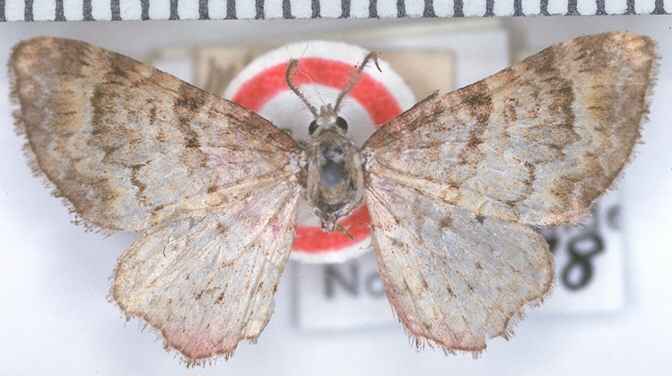Pasiphila Aristias on:
[Wikipedia]
[Google]
[Amazon]
''Pasiphila aristias'' is a species of
 Meyrick described this species as follows:
Meyrick described this species as follows:
moth
Moths are a paraphyletic group of insects that includes all members of the order Lepidoptera that are not butterflies, with moths making up the vast majority of the order. There are thought to be approximately 160,000 species of moth, many of w ...
in the family Geometridae
The geometer moths are moths belonging to the family Geometridae of the insect order Lepidoptera, the moths and butterflies. Their scientific name derives from the Ancient Greek ''geo'' γεω (derivative form of or "the earth"), and ''met ...
. It was described by Edward Meyrick
Edward Meyrick (25 November 1854, in Ramsbury – 31 March 1938, at Thornhanger, Marlborough) was an English schoolmaster and amateur entomologist. He was an expert on microlepidoptera and some consider him one of the founders of modern m ...
in 1897 and is endemic
Endemism is the state of a species being found in a single defined geographic location, such as an island, state, nation, country or other defined zone; organisms that are indigenous to a place are not endemic to it if they are also found elsew ...
to New Zealand
New Zealand ( mi, Aotearoa ) is an island country in the southwestern Pacific Ocean. It consists of two main landmasses—the North Island () and the South Island ()—and over 700 smaller islands. It is the sixth-largest island count ...
. This species is found in both the North
North is one of the four compass points or cardinal directions. It is the opposite of south and is perpendicular to east and west. ''North'' is a noun, adjective, or adverb indicating Direction (geometry), direction or geography.
Etymology
T ...
and South Islands and inhabits subalpine and native forest. Adults are on the wing in December and January and are attracted to light.
Taxonomy
This species was first described byEdward Meyrick
Edward Meyrick (25 November 1854, in Ramsbury – 31 March 1938, at Thornhanger, Marlborough) was an English schoolmaster and amateur entomologist. He was an expert on microlepidoptera and some consider him one of the founders of modern m ...
in 1897 and named ''Chloroclystis aristias''. George Hudson
George Hudson (probably 10 March 1800 – 14 December 1871) was an English railway financier and politician who, because he controlled a significant part of the railway network in the 1840s, became known as "The Railway King"—a title conferr ...
discussed and illustrated this species in both his 1898 and his 1928 books under that name. In 1971 John S. Dugdale placed this species in the genus ''Pasiphila''. In 1988 Dugdale discussed this species under the name ''Pasiphila aristias'' and in 2010 Robert Hoare in the New Zealand Inventory of Biodiversity followed this placement. The male holotype
A holotype is a single physical example (or illustration) of an organism, known to have been used when the species (or lower-ranked taxon) was formally described. It is either the single such physical example (or illustration) or one of several ...
specimen, collected by George Hudson in a limestone valley at the foot of Mount Peel in the Mount Arthur tablelands at an elevation of about 4000 ft, is held at the Natural History Museum, London
The Natural History Museum in London is a museum that exhibits a vast range of specimens from various segments of natural history. It is one of three major museums on Exhibition Road in South Kensington, the others being the Science Museum an ...
.
Description
 Meyrick described this species as follows:
Meyrick described this species as follows:
Distribution
''P. aristias'' is endemic to New Zealand and can be found on both the North and South Islands. Although considered an uncommon species by Brian Patrick, it has been observed in its type locality of Mount Peel in the Mount Arthur tablelands as well as onMount Taranaki
Mount Taranaki (), also known as Mount Egmont, is a dormant stratovolcano in the Taranaki region on the west coast of New Zealand's North Island. It is the second highest point in the North Island, after Mount Ruapehu. The mountain has a seco ...
, in the Wellington Region
Greater Wellington, also known as the Wellington Region (Māori: ''Te Upoko o te Ika''), is a non-unitary region of New Zealand that occupies the southernmost part of the North Island. The region covers an area of , and has a population of
T ...
, in the Homer Tunnel area in Fiordland, in Canterbury at the Orton Bradley Park
Orton Bradley Park is a forest park of some with its entrance close to the south shore of Lyttelton Harbour / Whakaraupō in New Zealand. It is managed as a not-for-profit private enterprise with a board of governors appointed by local communitie ...
, in Dunedin
Dunedin ( ; mi, Ōtepoti) is the second-largest city in the South Island of New Zealand (after Christchurch), and the principal city of the Otago region. Its name comes from , the Scottish Gaelic name for Edinburgh, the capital of Scotland. Th ...
and on Ben Lomond
Ben Lomond (Scottish Gaelic: Beinn Laomainn, 'Beacon Mountain'), , is a mountain in the Scottish Highlands. Situated on the eastern shore of Loch Lomond, it is the most southerly of the Munros. Ben Lomond lies within the Ben Lomond National Me ...
in Otago.
Behaviour
Adults are on the wing in December and January and are attracted to light.Habitat
This species inhabits subalpine and native forest.References
Moths described in 1897 aristias Moths of New Zealand Endemic fauna of New Zealand Taxa named by Edward Meyrick Endemic moths of New Zealand {{Eupitheciini-stub